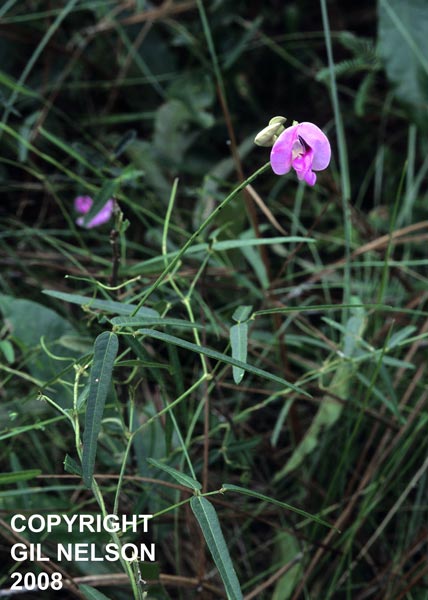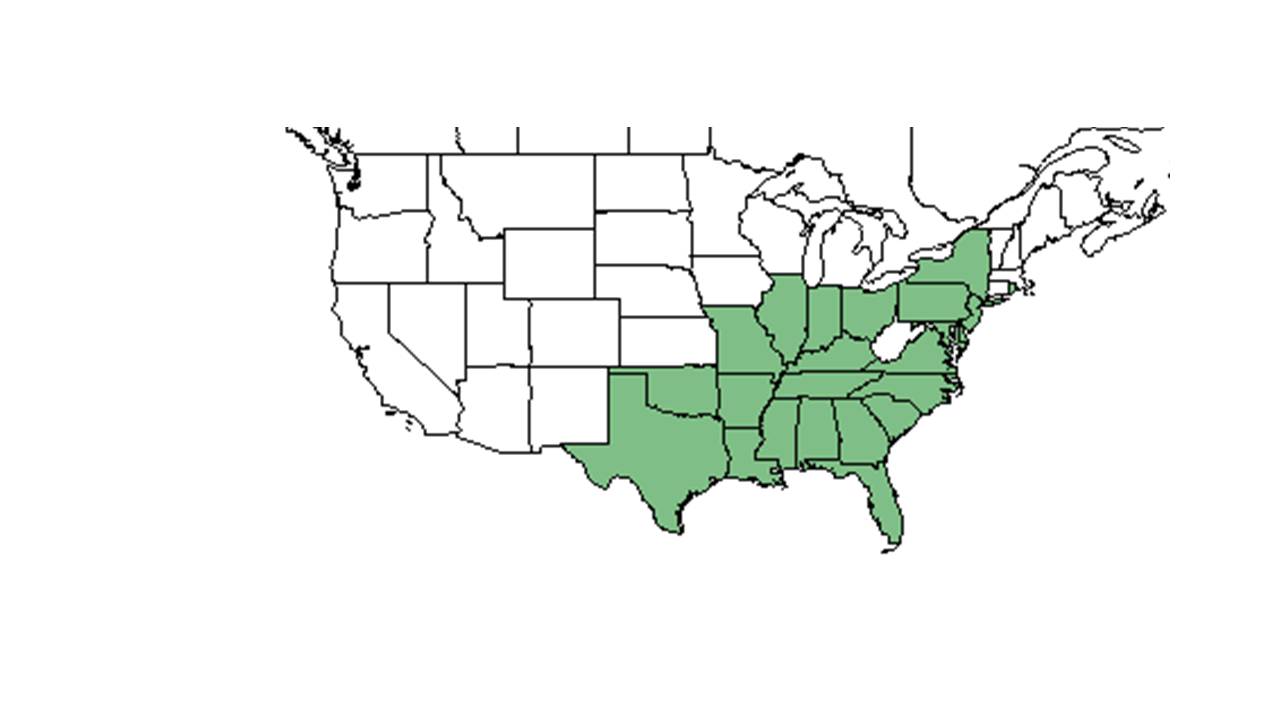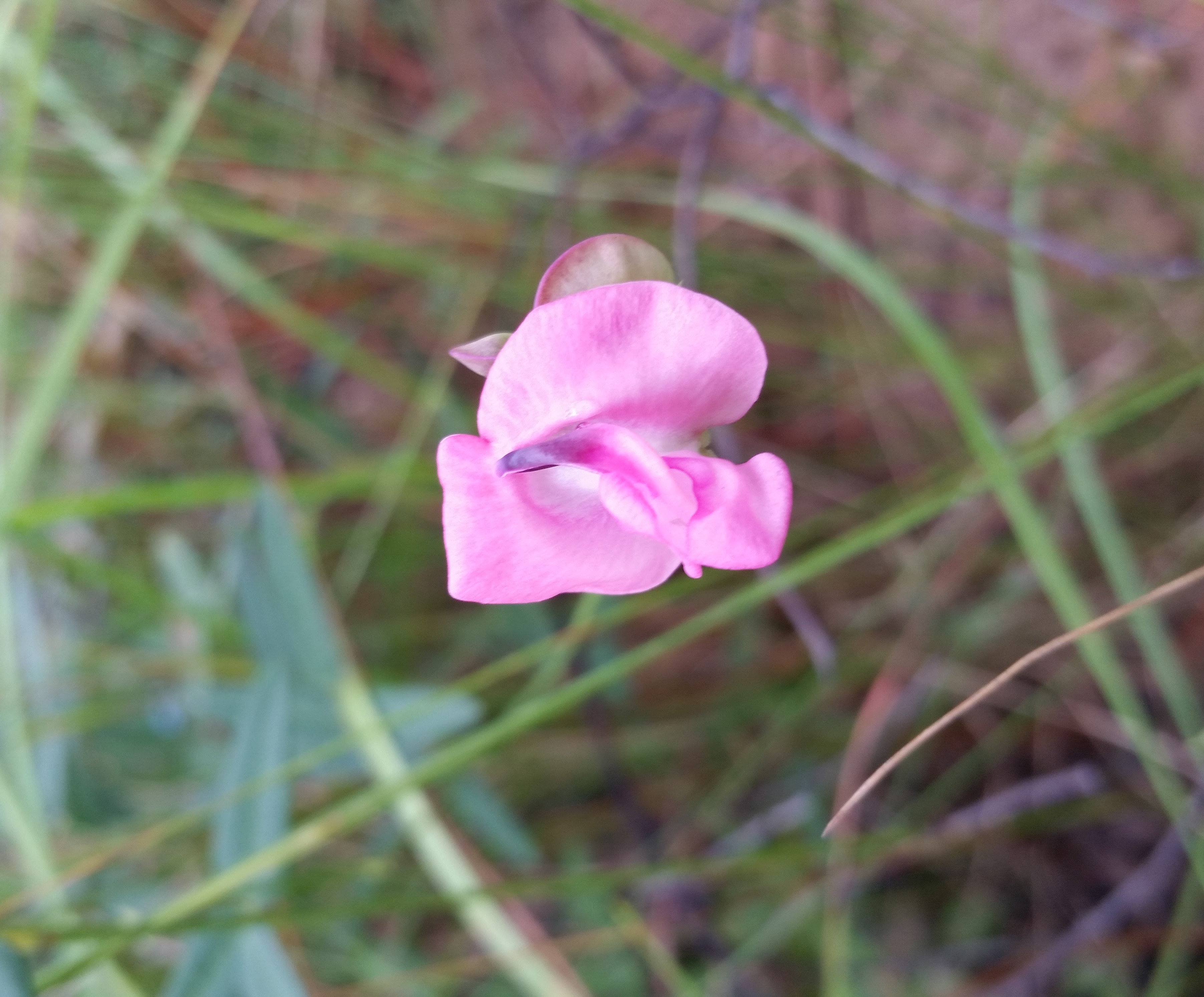Strophostyles umbellata
| Strophostyles umbellata | |
|---|---|

| |
| Photo taken by Gil Nelson | |
| Scientific classification | |
| Kingdom: | Plantae |
| Division: | Magnoliophyta – Flowering plants |
| Class: | Magnoliopsida – Dicotyledons |
| Order: | Fabales |
| Family: | Fabaceae ⁄ Leguminosae |
| Genus: | Strophostyles |
| Species: | S. umbellata |
| Binomial name | |
| Strophostyles umbellata (Muhl. ex Willd.) Britton | |

| |
| Natural range of Strophostyles umbellata from USDA NRCS Plants Database. | |
Common name: pink fuzzybean
Contents
Taxonomic notes
Synonyms: Strophostyles umbellata var. paludigena Fernald; S. umbellata var. umbellata
Description
"Annual or perennial, trailing, twining or weakly climbing, herbaceous vines. Leaves pinnately 3-foliolate; leaflets entire but often basally lobed, petiolulate, stipellate; stipules striate, small, persistent. Racemes axillary, long-pedunculate with few to several, closely clustered, apparently subcaptiate, subsessile, papilionaceous flowers subtended by a small, striate bract and with a pair of striate, persistent bractlets just beneath the flower. Calyx more or less 2-lippd, tube campanulate, the 2 upper lobes almost completely fuse and the lobes therefore appearing as 4, the lowermost lobe longest; petals pink, purple or nearly white, the keel beaked and strongly incurved but not coiled, longer than the wings; stamens diadelphous 9 and 1; ovary sessile or nearly so, style curved, bearded along its inner side. Legume linear, terete or nearly so, with valves laterally twisted after dehiscence; seeds several, woolly." - Radford et al 1964
'Trailing or weakly twining, perennial vine with stems (0.3) 0.6-1.5 (2) m long and with at least the younger portion densely and retrorsely or spreading pubescent. Leaflets widely to narrowly ovate, lanceolate to elliptic or oblong, unlobed, 2-5 cm long, glabrous or nearly so above and below or somewhat appressed-pubescent beneath. Racemes 1-2.5 dm long with few to several, capitately clustered flowers; pedicels to 1 mm long subtended by oblong bract to 0.7 mm long and with pairs of ovate to oblong, obtuse bractlets 0.8-1 mm long. Calyx tube glabrous or nearly so, 2-2.5 mm long, lobes glabrous except for the ciliate margins and usually strigose lowermost lobe; petals pink or pale purple, often fading yellowish, the standard 1-1.4 cm long. Legumes sparsely appressed-pubescent, 3-6.5 cm long, 4 mm broad; seeds 3-6 mm long." - Radford et al 1964
Distribution
Ecology
Habitat
In the Coastal Plain region, S. umbellata has been found in loamy sand of a depression bordering mesic flatwoods; understory of upland slash pinewoods; transition zone of longleaf pine flatwoods to pine savanna; semi-shaded loam in old growth longleaf pine forest; sand of open meadow; low savanna above creek floodplain; dry pine barrens; open pinewoods; open grassy clearing of upland pine woodland; floodplain shores of lakes; upland deciduous woods; slopes and ridges; and in a grassy area just above a fresh water marsh (FSU Herbarium; [1]). It is predominately found in native groundcover, such as the upland pines of South Georgia.[2] It has been documented in disturbed habitats such as loamy sand of roadside slopes, powerline corridors, loamy soil of roadside ditches, dikes on lake shores, white sandy bottoms of dried ponds, and in clay roadside banks. Outside of the Coastal Plain region in Indiana, it has been found in burned limestone glades. [3]
Soil types include loamy sand, loam, sand, loamy soil, and clay (FSU Herbarium). Associated species include Crotalaria, Desmodium, Cassia fasciculata, Cephalanthus, Desmodium ochroleucum, D. lineatum, Habenaria integra, H. ciliaris, and Aster umbellatus (FSU Herbarium).
Phenology
It blooms from late June to early July. [1] It has been observed to flowering June through September and fruiting August and September (FSU Herbarium).
Seed dispersal
According to Kay Kirkman, a plant ecologist, this species disperses by gravity. [4]
Fire ecology
It occurs in areas that are frequently burned. [1]
Use by animals
It is included in bobwhite quail diet. [5]
Conservation and management
Cultivation and restoration
Photo Gallery
References and notes
Florida State University Robert K. Godfrey Herbarium database. URL: http://herbarium.bio.fsu.edu. Last accessed: July 2015. Collectors: Loran C. Anderson, Aaron Leblanc, James R. Burkhalter, A. F. Harris, Nancy E. Jordan, Wilson Baker, James R. Burkhalter, Dennis Hardin, A. H. Curtiss, Gary R. Knight, Thomas P. Kruas, R.K. Godfrey, D. B. Ward, S. C. Hood, Sidney McDaniel, R. Komarek, Rodie White, Leon Neel, Lisa Keppner, John B. Nelson, A. E. Radford, W. R. Anderson, Samuel B. Jones, Jr., Joseph Ewan, R. Kral, Robert A. Norris, Nancy Craft Coile, Nan Bates, Geo M. Merrill, Billie Bailey. States and Counties: Alabama: Macon. Florida: Alachua, Calhoun, Columbia, Duval, Escambia, Franklin, Gulf, Holmes, Jackson, Leon, Liberty, Nassau, Santa Rosa, Wakulla, Walton, Washington. Georgia: Baker, Elbert, Grady, Thomas. Louisiana: Rapides, Union. Mississippi: Jasper, Lamar, Oktibbeha. North Carolina: Carteret. South Carolina: Fairfield, Pickens, Richland. Texas: Houston. Compiled by Tall Timbers Research Station and Land Conservancy.
Radford, Albert E., Harry E. Ahles, and C. Ritchie Bell. Manual of the Vascular Flora of the Carolinas. 1964, 1968. The University of North Carolina Press. 640. Print.
- ↑ 1.0 1.1 1.2 Hainds, M. J., R. J. Mitchell, B. J. Palik, L. R. Boring and D. H. Gjerstad. 1999. Distribution of native legumes (Leguminoseae) in frequently burned longleaf pine (Pinaceae)-wiregrass (Poaceae) ecosystems. American Journal of Botany 86:1606-1614.
- ↑ Ostertag, T.E., and K.M. Robertson. 2007. A comparison of native versus old-field vegetation in upland pinelands managed with frequent fire, South Georgia, USA. Pages 109–120 in R.E. Masters and K.E.M. Galley (eds.). Proceedings of the 23rd Tall Timbers Fire Ecology Conference: Fire in Grassland and Shrubland Ecosystems.
- ↑ Wade, K. A. and E. S. Menges. 1987. Effects of fire on invasion and community structure of a southern Indiana cedar barrens. Indiana Academy of Science 96:273-286.
- ↑ Kay Kirkman, unpublished data, 2015.
- ↑ Sweeney, J. M., C. R. Wenger and N. S. Yoho. 1981. Bobwhite quail food in young Arkansas loblolly pine plantations. Arkansas Experiment Station bulletin 852. Fayetteville, AR, University of Arkansas, Divisionn of Agriculture, Agricultural Experiment Station.
